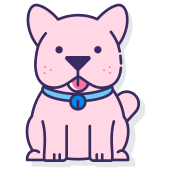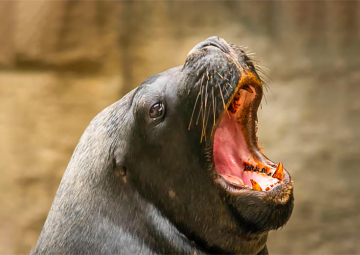Birds
Voluntary collar training with Darcy the Moluccan Cockatoo

Holly Garson is head exotic animal trainer at Flamingoland Zoo. The company she works for is called APAB Ltd who provides the bird and sealion displays at Flamingoland, and animals for film and television productions. She joined the company at 14 years old doing weekend work and she is the manager of the bird show 19 years later.
She continued my education after secondary school whilst working part time at the zoo studying a national diploma in animal management, an honours degree in aquatic zoology and research masters in the dietary selection and behaviour of the Angolan black and white colobus of Magombera forest Tanzania, this was through the Udzungwa Forest Project (UFP) which is funded by Flamingoland.
In this article she will show us the opportunity she has every day to train cooperative behaviors with different species, and in this particular case the training of a protective collar with Darcy, a Moluccan cockatoo (Cacatua moluccensis).
{youtube}https://youtu.be/Xifvgrus_E4{/youtube}
Introduction
Earlier this year my own parrot Peewee a Red Lored Amazon (Amazona autumnalis) developed a fungal lump on his leg which needed to be removed. After surgery Peewee had to wear a dressing on the wound which he would not leave alone and began to tear apart. Our zoo vet Gemma Graham decided it was necessary for Peewee to wear a soft collar to avoid any further damage to the dressing covering the wound which she very quickly created at the practice.

As Peewee has never had any experience wearing a collar, he did appear to be very frustrated having it around his neck on occasions. Where possible I would provide him with breaks from wearing it and supervise him but it was necessary for him to have it on the majority of the time. The difficulty I had
getting the collar back on or removing it from around his head made me immediately think this is something I need to train all the birds to do at work in preparation for cooperative health related to this should any of them require this in the future. In almost 20 years of working with birds I have not once had a bird that required this type of surgery after care!
To give Peewee a rest period from wearing the collar when he had fully recovered, I decided to train our Moluccan cockatoo Darcy to voluntarily have the collar placed around her neck first as Peewee had shown a strong aversion to the object. Instead I created a training plan for Peewee to cooperatively have F10 ointment put onto the soles of his claws as part of his aftercare. After months of work Peewee will now lift his feet voluntarily to have the ointment administered whilst being weighed each morning!
Voluntary collar training with Darcy the Moluccan Cockatoo
Moving back to the soft collar work, initially to train Darcy to accept the collar, I introduced her to different materials and collar shaped objects. This species of cockatoo can be very “foot orientated” resulting in Darcy wanting to constantly hold the material and collars in her claws. Each time the collar would be placed near Darcy’s head or neck she would push the collar down and grasp it in her feet. To encourage Darcy to stay still whilst approaching with the object I decided a target should be used.
Before the collar training, I had worked previously on building duration on the target with the parrots. Using the target proved to be a great success! The bird show team got to the stage of placing different safe objects around Darcy’s neck with no aversion shown at all! I encouraged the rest of the bird team to place the soft collar with the velcro fasten on to Darcy in a number of different ways from different angles, to open up and close the velcro fastening regularly and confidently in front of Darcy to build her confidence with these actions.


From research I have conducted there are a wide variety of different collar types for birds in particular parrots. I decided to practise with two different style of collars to further work on desensitization. After a small amount of work requiring the target Darcy showed signs of understanding she needed to stay still and keep her claws down away from the collar. The target was then removed from sessions and the sessions were then focused on placing the collar around Darcy in different ways and building duration of the collar being worn.
Once Darcy was comfortable with the velcro collar I added a card collar to training sessions to teach Darcy to put her head through the hole of collar as many parrot soft collars are designed like this. This was the style that Peewee had be provided with, this allowed Darcy to build confidence with the collar being pulled over and off her head. I once again initially used the target to get Darcy to bring her head through the card collar’s hole. Within two sessions of performing this task the target once again was no longer required and Darcy will now just put her head straight through the hole voluntarily. Duration of the wearing the collar was then built throughout sessions.

This training allowed me to adapt different methods to suit the individual animal and I always feel that even if I didn’t plan or anticipate the need for a target to be used somewhere along the process a target always becomes such a useful tool. I will be extremely interested to train this behaviour with another individual that isn’t known to be so “foot orientated” to see if the same methods would be required or not. I anticipate the interest with holding the collar in an individual’s claw would not be as great with other species of parrots at our facility. The plan is to train all of our birds to voluntarily accept a collar starting with the rest of the parrot section. This work has been a great team effort even down to having a staff member freed up to film sessions for our records and to keep a log of progress. I would like to say well done to all of our team for their hard work, patience and course to our amazing Darcy!
Future cooperative health care plans
The plan I have for all the birds at the display is to have each individual dependant on species and capabilities trained to perform a number of c oope r a tiv e c ar e behaviours in the future. We currently have parrots that will except medication from syringe, Peewee my Amazon has been placing his head
into a plastic cup in preparation for anaesthesia cup training, parrots that will engage in voluntary nail trims, wing opens, a Crested Seriema (Cariama cristata) that will stand in hibi-scrub foot baths, have
hibi-scrub and f10 ointment administered to his feet (this still does a need a little more work but its all going in the right direction). I do have so many more ideas and behaviours I want to train with the birds and our sealions, who already do a number of different health behaviours. You will hopefully hear from me again soon perhaps showing you some more of our cooperative care we do with our animals, in particular the work with the Seriema.


Finally, I would like to thank my team for their hard work, Darcy for their enormous patience and WeZooit team for allowing me to show you our work.
And remember, if it’s possible… WeZooit!
SHARE
For any questions, contact us.


















